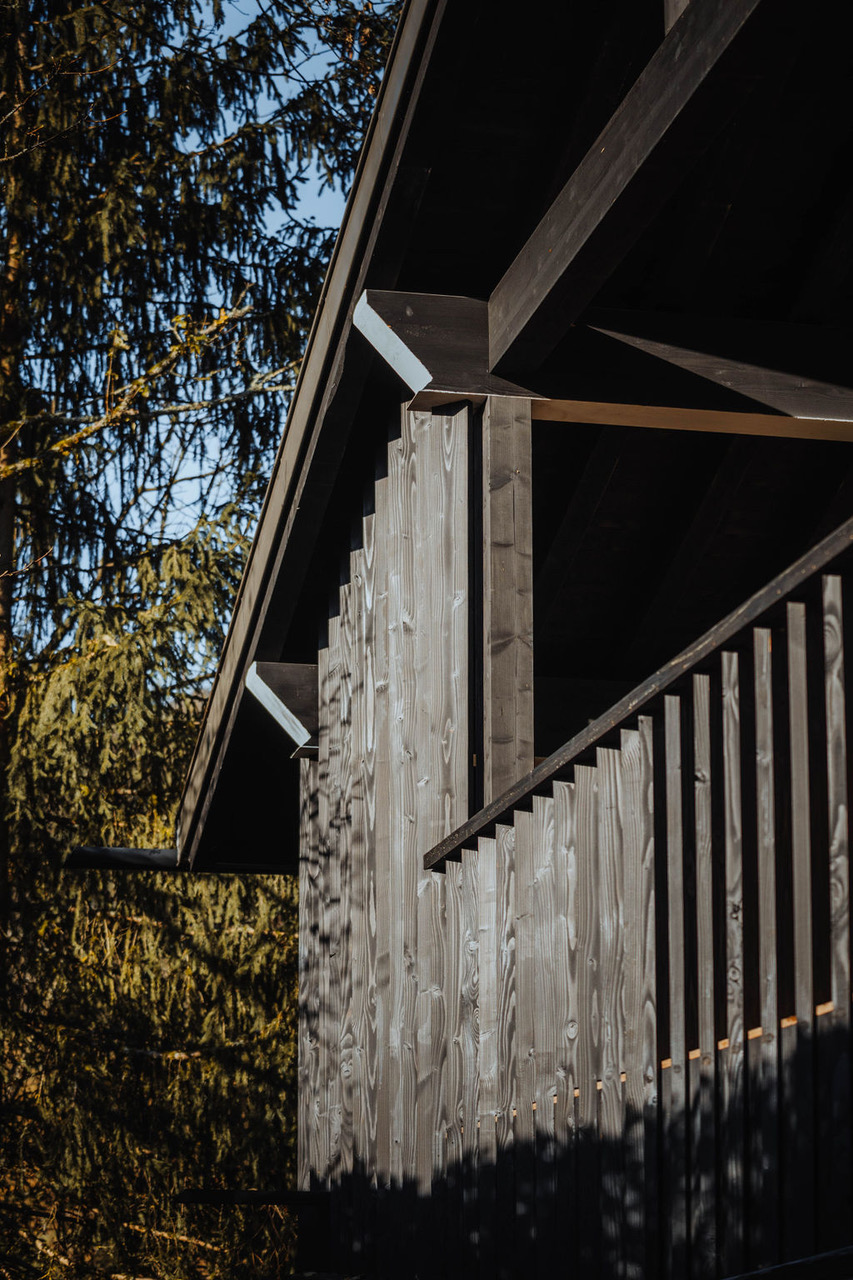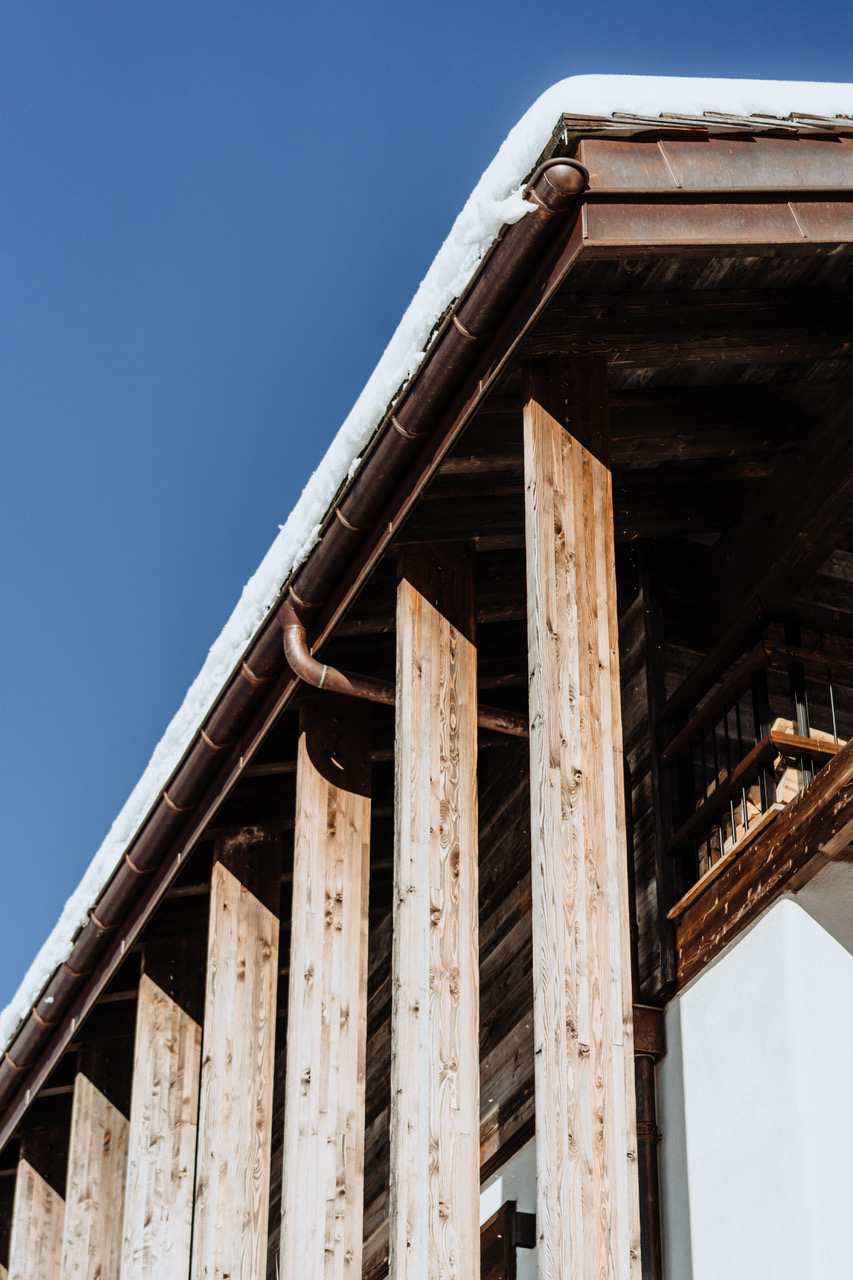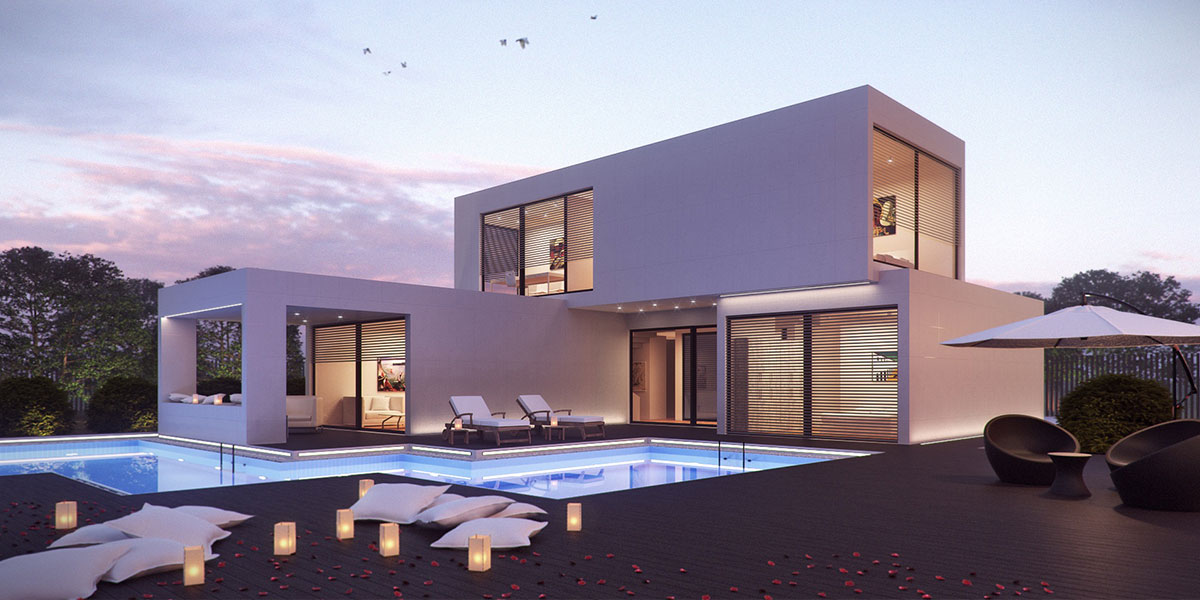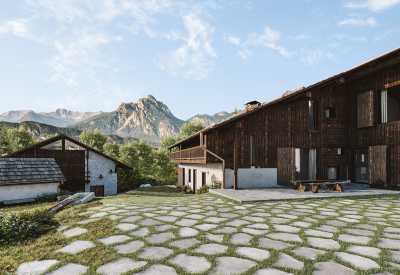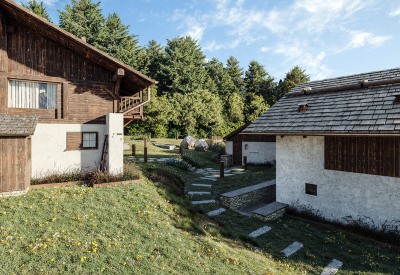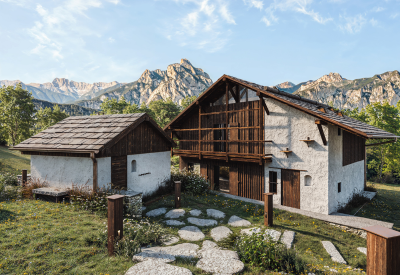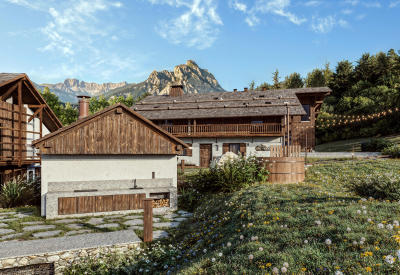Ferme de la combe
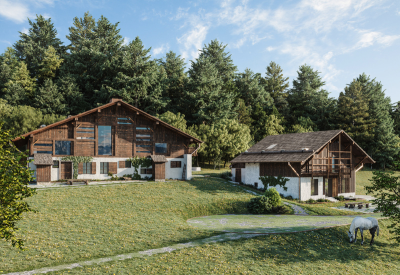
Description du projet
Il s’agit d’un corps de ferme bâtiment repéré d’intérêt patrimonial agro-pastoral. L’idée est de venir se glisser dans ce que les anciens ont bâti, dans le respect de l’architecture et de l’organisation empirique du lieu.
Nous considérons que l’ensemble bâti constitue un des derniers témoignages du patrimoine bâti agro-pastoral du Pays du Mont- Blanc resté en l’état depuis la fin de la seconde guerre mondiale, par conséquent le projet se doit de préserver ces édifices et leurs implantations. Ses façades portent les marques de l'histoire, d'une activité et d'une manière de vivre passée, qui en font une véritable valeur ajoutée pour mener à bien un projet devant s'approcher de la restauration. Ce projet est l'occasion de redonner vie à ce patrimoine en réinventant une nouvelle manière de vivre en montagne, au sein d'un écrin vernaculaire.
L'intention est d'assumer les temporalités, de composer avec le réel, en jouant sur les contrastes entre extérieur et intérieur, affirmant le caractère d'une vieille ferme témoignant des marques du temps et d’intérieurs contemporains travaillés en finesse. Le projet vise à valoriser l’aspect extérieur en conservant et en réutilisant les vieilles pièces de bois des constructions existantes, qu’elles soient structurelles ou de bardage, en restaurant les parties maçonnées avec la reprise de l’enduit à la chaux sableuse talochée laissant ici et là, apparaître quelques pierres éparses.
Il nous a donc paru indispensable de faire un relevé très précis et sensible de chacune des façades du corps de ferme. Tel un travail archéologique mené sur les traces de quatre architectures spécifiques que sont la ferme, la remise, le fradier et le four à pain, avant de juger du type d’intervention le plus approprié pour chacune.
La charpente de la ferme est dans la mesure du possible conservée en l’état ou restaurée. Un travail précis de repérage pièce par pièce de la charpente, est mené avec un charpentier.
Les couvertures de chacun des édifices seront rénovées en tavaillons en remplacement des vieilles tôles ondulées (utilisées à l’époque pour leur côté pratique et peu onéreuses) permettant de redonner une harmonie visuelle entre chacune des toitures.
Afin d’éviter un parking à ciel ouvert devant la ferme et dans le but de recréer l’environnement d’antan, un parking souterrain permettant de faire disparaître tout véhicule est projeté en aval du corps de ferme, en partie Sud-Ouest du terrain sous le champ. Le geste est simple, lever délicatement le terrain à la manière d’un drapé révélant le sous-sol. Les aménagements sont limités et sans impact majeur, les matériaux sont choisis pour conduire un projet valorisant les caractéristiques architecturales de ce site dans un environnement de montagne.
Autour de la ferme, afin de circuler entre les dépendances, les cheminements sont faits de pierres disposées au sol. Les terrasses extérieures de la ferme et de la remise sont aménagées en pierre avec pose en Opus Incertum laissant pousser de l’herbe entre chacune. Ceci permet d’éviter les terrasses bois trop marquées et trop sophistiquées en pied de tels édifices anciens.
Les arbres fruitiers situés dans la prairie au Nord de la ferme, sont conservés et certains seront replantés. La forêt en amont du corps de ferme est conservée, une nouvelle forêt de conifères sera plantée en lisière de la propriété dans le prolongement de la foret existante.
Plusieurs bouleaux sont plantés dans le champ à l’entrée de la propriété, dissimulant entre les troncs et les feuillages, l’accès au parking souterrain. Le reste de la propriété restera en prairie.
L’entrée du garage souterrain est dissimulée dans la topographie existante. La terre vient mourir naturellement le long de l’accès pour se rapprocher au maximum de la morphologie existante de la prairie. La voie d’accès est légèrement en pente. A la manière d’une faille, comme si le terrain s’était ouvert, la façade de cette entrée de garage est constituée de lames verticales d’acier oxydé. La partie supérieure est plantée, avec des plantes tombantes et grimpantes permettant de fondre l’entrée du garage dans son environnement, tel un rocher qui s’est recouvert de végétation avec le temps, au milieu du champ.
Cette rénovation s'inscrit dans son environnement au sein d’une vaste prairie vallonnée, entourée de forêts d’épicéas. L'équilibre existant n'est pas perturbé, conservant ainsi l’harmonie du corps de ferme et de ses dépendances, perpétuant l’ambiance particulière du site. Ainsi, le caractère du lieu est préservé, le verger existant au Nord du terrain est conservé et certains arbres fruitiers sont ajoutés pour compenser la perte d'arbres trop vieux.
Le bassin, élément central de l'ensemble bâti garde son emplacement et se verra simplement entouré de dalles de pierre de pays, disposées en opus incertum s’intégrant à l’herbe et la prairie pour faciliter l’accès à chacun des édifices de ce corps de ferme. Conserver ou retrouver les abords traditionnels de la ferme est essentiel, un élément comme le bassin fait partie intégrante des éléments paysagers. L’esthétique du lieu est conservé, au delà de cet aspect c’est l'écosystème pré-existant qui est préservé. Il nous paraît important ici de maintenir un sens et des usages paysager ancestraux autour de cette ferme, et de favoriser les interactions avec les nouveaux habitants de la ferme et la vie de tous les êtres vivants de ce milieu naturel.
This is a farm building of agricultural and pastoral heritage interest. Theidea is to slip into what the ancestors built, respecting the architectureand empirical organisation of the place.
We consider that the built ensemble is one of the last remainingexamples of the agricultural and pastoral heritage of the Mont Blancregion that has remained unchanged since the end of the SecondWorld War. The project therefore aims to preserve these buildings andtheir location. Its façades bear the marks of history, of a past activityand way of life, which give it real added value for a project that aims torestore it to its former glory. This project is an opportunity to breathenew life into this heritage by reinventing a new way of life in themountains, within a vernacular setting.
The intention is to embrace the passage of time and work with reality,playing on the contrasts between exterior and interior, affirming thecharacter of an old farmhouse bearing the marks of time andcontemporary interiors crafted with finesse. The project aims toenhance the exterior by preserving and reusing old pieces of woodfrom the existing structures, whether structural or cladding, andrestoring the masonry with a new coat of sandy lime plaster, leaving afew scattered stones visible here and there.We therefore felt it was essential to make a very precise and sensitivesurvey of each of the farmhouse facades. This was like archaeologicalwork, tracing the four specific architectural features of the farmhouse,the shed, the fradier (a type of barn) and the bread oven, beforedeciding on the most appropriate type of intervention for each one.
The farmhouse's roof structure is being preserved or restored as far aspossible. A carpenter is working on a precise piece-by-piece survey ofthe framework.
The roofs of each of the buildings will be renovated with shingles toreplace the old corrugated iron sheets (used at the time for theirpracticality and low cost), restoring visual harmony between each of theroofs.
In order to avoid an open-air car park in front of the farm and torecreate the environment of yesteryear, an underground car park isplanned downstream of the farm building, in the south-western part ofthe land under the field. The gesture is simple: delicately lift the groundlike a drape to reveal the basement. The developments are limited andhave no major impact, and the materials have been chosen to enhancethe architectural features of this site in a mountain environment.
Around the farm, the paths between the outbuildings are made ofstones laid on the ground. The outdoor terraces of the farmhouse andthe shed are laid out in stone in an Opus Incertum pattern, allowinggrass to grow between each stone. This avoids the use of woodenterraces, which would be too prominent and sophisticated at the foot ofsuch old buildings.The fruit trees in the meadow to the north of the farm will be preservedand some will be replanted. The forest upstream from the farmhousewill be preserved, and a new conifer forest will be planted on the edgeof the property as an extension of the existing forest.
Several birch trees are planted in the field at the entrance to theproperty, concealing the access to the underground car park betweentheir trunks and foliage. The rest of the property will remain asmeadow.The entrance to the underground garage is concealed within theexisting topography. The earth slopes naturally along the access roadto blend in as much as possible with the existing morphology of themeadow. The access road is slightly sloped. Like a fault line, as if theground had opened up, the façade of this garage entrance is made upof vertical strips of oxidised steel. The upper part is planted withhanging and climbing plants, allowing the garage entrance to blend intoits surroundings, like a rock covered with vegetation over time, in themiddle of a field.This renovation blends into its surroundings in a vast rolling meadowsurrounded by spruce forests. The existing balance is not disturbed,thus preserving the harmony of the farmhouse and its outbuildings andperpetuating the special atmosphere of the site. The character of theplace is preserved, the existing orchard to the north of the site isretained and some fruit trees are added to compensate for the loss oftrees that were too old.The pond, a central feature of the built environment, will remain in itscurrent location and will simply be surrounded by local stone slabs laidin opus incertum, blending in with the grass and meadow to facilitateaccess to each of the farm buildings. It is essential to preserve orrestore the traditional surroundings of the farm, as features such as thepond are an integral part of the landscape. The aesthetics of the sitewill be preserved, but beyond this, it is the pre-existing ecosystem thatwill be preserved. We believe it is important to maintain the ancestrallandscape and its uses around this farm, and to encourage interactionbetween the new inhabitants of the farm and all living beings in thisnatural environment.
